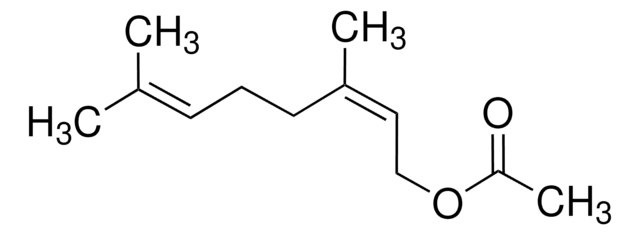W327506
Dimethyltrisulfid
≥98%, FG
Synonym(e):
2,3,4-trithiapentane, Methylsulfanyldisulfanylmethane
About This Item
Empfohlene Produkte
Biologische Quelle
synthetic
Qualitätsniveau
Qualität
FG
Halal
Kosher
Agentur
meets purity specifications of JECFA
Einhaltung gesetzlicher Vorschriften
EU Regulation 1334/2008 & 178/2002
Assay
≥98%
Brechungsindex
n20/D 1.602 (lit.)
bp
58 °C/15 mmHg (lit.)
mp (Schmelzpunkt)
−68 °C (lit.)
Dichte
1.202 g/mL at 25 °C (lit.)
Anwendung(en)
flavors and fragrances
Dokumentation
see Safety & Documentation for available documents
Nahrungsmittelallergen
no known allergens
Organoleptisch
meaty; alliaceous; sulfurous
SMILES String
CSSSC
InChI
1S/C2H6S3/c1-3-5-4-2/h1-2H3
InChIKey
YWHLKYXPLRWGSE-UHFFFAOYSA-N
Suchen Sie nach ähnlichen Produkten? Aufrufen Leitfaden zum Produktvergleich
Verwandte Kategorien
Allgemeine Beschreibung
Anwendung
- Exploring the binding affinity and characteristics of DcitOBP9 in citrus psyllids.: This study investigates the binding properties of dimethyl trisulfide (DMTS) with DcitOBP9, an odorant-binding protein in citrus psyllids, providing insights into the potential role of DMTS in pest management strategies (Pei et al., 2024).
Signalwort
Warning
H-Sätze
Gefahreneinstufungen
Acute Tox. 4 Oral - Eye Irrit. 2 - Flam. Liq. 3 - Skin Irrit. 2 - STOT SE 3
Zielorgane
Respiratory system
Lagerklassenschlüssel
3 - Flammable liquids
WGK
WGK 3
Flammpunkt (°F)
132.8 °F - closed cup
Flammpunkt (°C)
56 °C - closed cup
Persönliche Schutzausrüstung
Eyeshields, Faceshields, Gloves, type ABEK (EN14387) respirator filter
Hier finden Sie alle aktuellen Versionen:
Besitzen Sie dieses Produkt bereits?
In der Dokumentenbibliothek finden Sie die Dokumentation zu den Produkten, die Sie kürzlich erworben haben.
Kunden haben sich ebenfalls angesehen
Unser Team von Wissenschaftlern verfügt über Erfahrung in allen Forschungsbereichen einschließlich Life Science, Materialwissenschaften, chemischer Synthese, Chromatographie, Analytik und vielen mehr..
Setzen Sie sich mit dem technischen Dienst in Verbindung.














